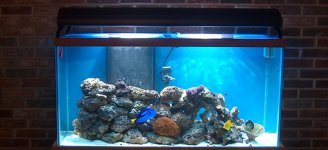A
Anonymous
Guest
I've been siphoning mine out with a 1/2 inch hose. I do about 20 gallons per weekend and have most of the sump done, but just part of the display tank. You hit snail operculums and bits of rubble etc, but it goes pretty smoothly.
I think the pods and mysids live in the rock, not in the sand, if that's an issue.
I think the pods and mysids live in the rock, not in the sand, if that's an issue.






